This post contains affiliate links. If you buy something from one of our links we may earn a commission. Thanks
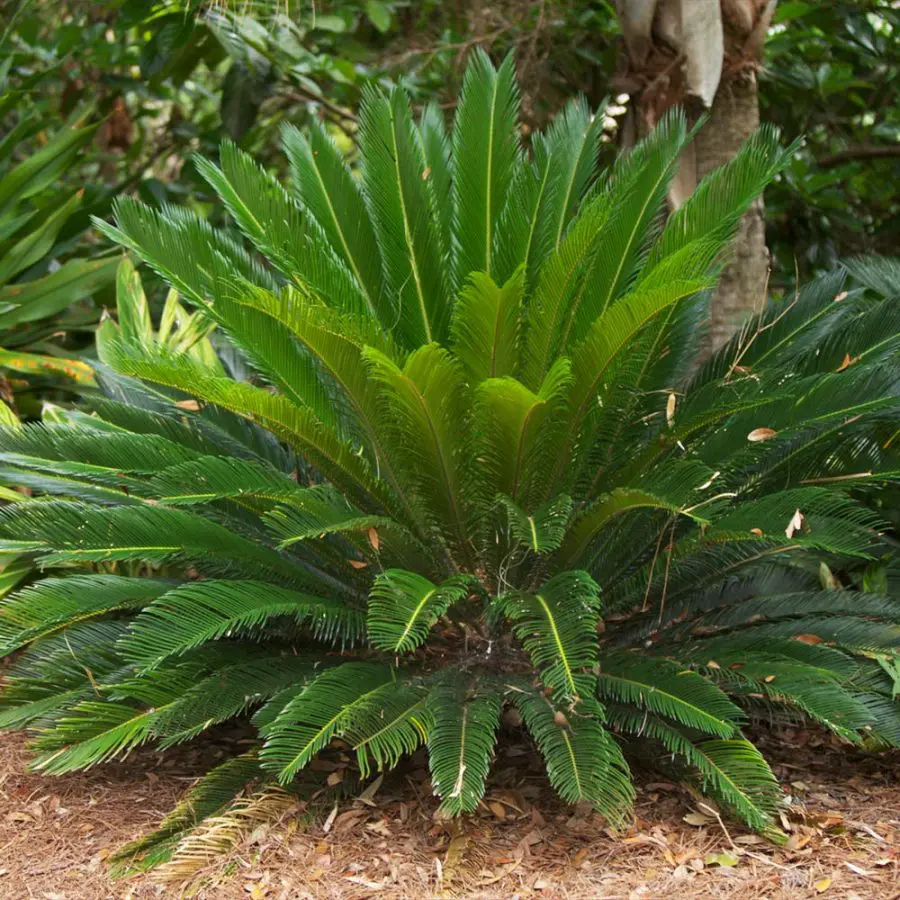
Discover the joys of growing sago palms in pots! Our step-by-step guide covers everything from potting to maintenance. Bring some green to your home today!
Growing Sago Palms in pots is a manageable task with the right approach. Ensure a well-draining soil mix, adequate sunlight, and regular watering.
Potted Sago Palms also require occasional fertilizing with a balanced, slow-release fertilizer to promote healthy growth. Regular inspection for pests and diseases will keep your Sago Palm thriving indoors or in your patio space.
Are you looking to add a touch of the tropics to your home? Growing sago palms in pots is an easy and fun way to bring a little bit of paradise to your living space.
These hardy and low-maintenance plants are perfect for container gardening and can thrive in a variety of indoor and outdoor settings.
In this guide, we’ll show you how to get started with growing sago palm trees in pots and share our best tips for keeping them healthy and happy. Let’s get started!
You can buy your Sago Palm here
Sago Palm Quick Facts
| Mature Height: | 4-6 ft Indoors 6-10 ft Outdoors |
| Mature Width: | 3-5 ft Indoors 6-10 ft Outdoors |
| Sunlight: | Full-Partial |
| Growth Rate: | Slow |
| Botanical Name: | Cycas revoluta |
| Grows Well In Zones: | 4-11 patio / 8-11 outdoors |
Sago Palms Outdoors?
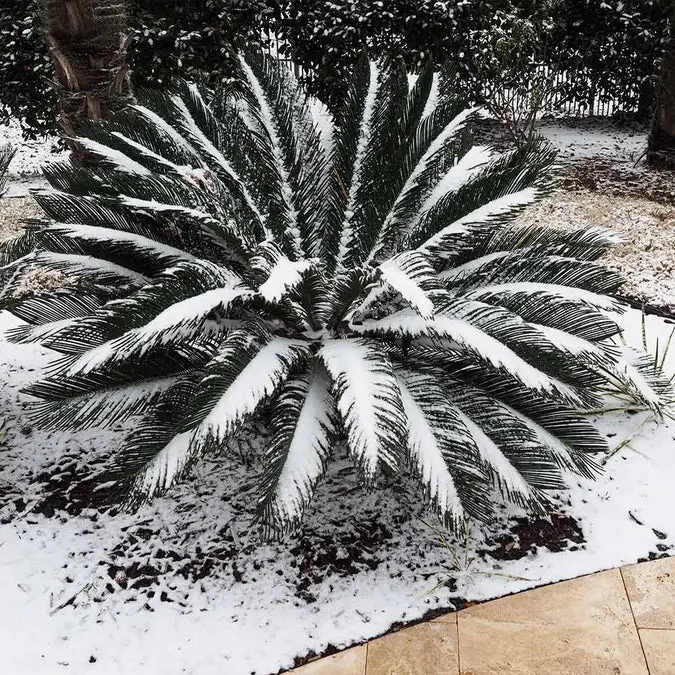
Sago palms are hardy in USDA zones 8b-11, which means they can tolerate low temperatures as low as 15°F (-9°C) for short periods.
However, it’s important to note that prolonged exposure to temperatures below 20°F (-6°C) can cause severe damage to the plant or even kill it.
So, it’s recommended to protect the plant during extreme cold weather conditions by covering it with blankets or moving it to a sheltered area.
I. Introducing The Sago Palm
Sago palms (Cycas revoluta) are a type of tropical plant that is native to Japan but are now popular across the globe for their unique appearance and low maintenance.
Although they may look like palms they are not true palms at all and are actually ancient plants dating back to prehistoric times
Cycas revoluta or sago palms are also known as the king sago palms, sago cycads, and Japanese sago palms.
They are a popular choice for container gardening because they don’t require a lot of space to grow and can thrive in smaller environments such as apartments or patios.
Additionally, they are known for their hardiness and long lifespan, making them a perfect choice for those looking for low-maintenance indoor plants that can last for years.
What We Cover In This Post For Sago Palm Care
In this post, we will cover everything you need to know about growing the sago palm plant in pots.
We include how to choose the right pot and soil, the steps to planting and fertilizing your sago palm, tips for watering and maintenance, and how to harvest sago palm seeds if applicable.
We will also discuss important factors such as lighting, temperature, and humidity, which are crucial for the health and growth of sago palms.
By the end of this post, you’ll have all the knowledge you need to successfully grow and care for sago palms in pots, and bring a touch of the tropics to your living space.
II. Choosing the Right Pot and Soil
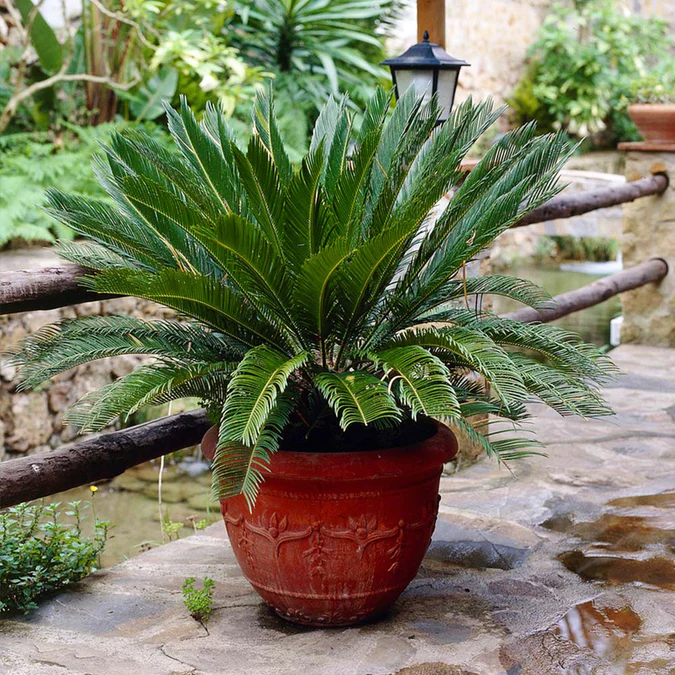
What kind of pot is best for sago palm care and why
• Choose a pot that is at least 2-4 inches wider than the base of the plant
• Select a pot with good drainage to avoid waterlogging
Clay or ceramic pots are good choices because they are heavier and provide stability for the plant. Make sure they have drainage holes.
What kind of soil do sago palms prefer?
Sago palms prefer well-drained soil that is rich in organic matter.
A good soil mixture for sago palms can be made by combining equal parts of coco coir and perlite.
Coco coir is a renewable and sustainable alternative to peat moss and provides good aeration and water retention for the roots.
Regular potting soil is too heavy so if you decide to use it amend it by adding extra perlite to it.
Perlite is a lightweight mineral that helps improve drainage and provides oxygen to the roots
Before potting, moisten the soil mixture and fill the pot about 1/3 of the way with the soil
Gently remove the sago palm from its current pot and loosen the roots before placing it in the new pot and filling it with soil
By choosing the right pot and soil for your sago palm, you’ll be providing it with the proper environment for healthy growth.
A pot that is too small or doesn’t have good drainage can lead to waterlogging and root rot, which can be fatal for the plant.
Likewise, using the right soil mixture can help the plant absorb the nutrients it needs and promote good root health.
With these tips, you’ll be well on your way to successfully growing sago palms in pots!
III. Planting Or Repotting Your Sago Palm
Now that you’ve chosen the right pot and soil for your sago palm, it’s time to plant or repot your plant.
Proper planting or repotting techniques are crucial to the success of indoor sago palms, as they will determine whether or not the plant will thrive in its new environment.
In this section, we’ll go over the best way for planting or repotting your sago palm, including tips for handling the plant, how to transplant it to its new home, and how to care for it after repotting.
With the right approach, you’ll give your sago palm the best chance for healthy growth and longevity.
Steps for planting a sago palm in a pot
• Before planting, make sure the soil is moist and the plant is hydrated
• Fill the pot with soil mixture, leaving enough space for the root ball
• Place the sago palm in the center of the pot, making sure the base of the trunk is level with the soil surface
• Gently add more soil around the plant, patting it down lightly to remove any air pockets
• Water the plant thoroughly until water starts to drain from the bottom of the pot
• For the first few weeks after planting, keep the soil consistently moist but not waterlogged
• After that, allow the soil to dry out slightly between watering, but don’t let it become bone dry
How to add fertilizer to the pot and when it’s necessary
Sago palms don’t require a lot of fertilizer, but you can use a slow-release, balanced fertilizer once or twice a year
Apply the fertilizer in the spring or early summer, following the instructions on the package
Don’t apply fertilizer in the fall or winter, as the plant may be dormant during these seasons
If you notice yellowing or stunted growth, it may be a sign that your sago palm needs fertilizer
Be sure to use a fertilizer specifically designed for palms, as other types may not have the proper nutrients
By following these steps for planting and fertilizing your sago palm, you’ll be setting this beautiful plant up for healthy growth in its new home.
Just remember to be patient and give the plant time to adjust to its new environment.
With proper care, your sago palm will be a beautiful addition to your indoor or outdoor space for years to come.
IV. Lighting
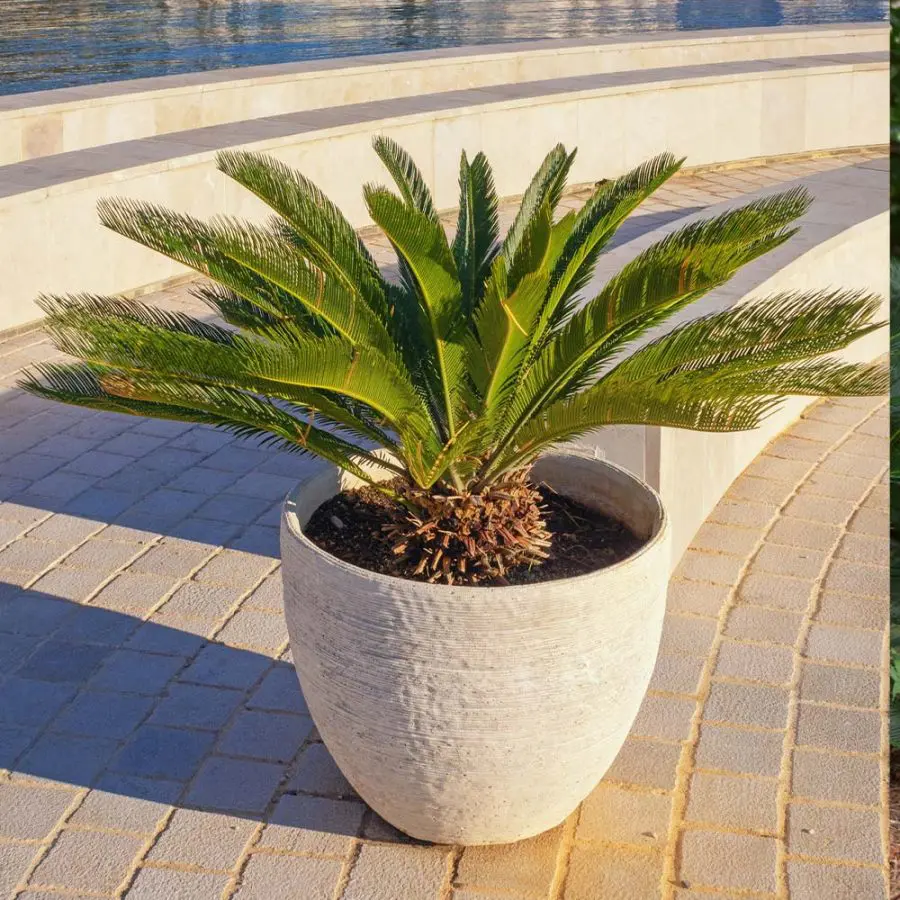
When it comes to growing sago palms in pots, providing adequate lighting is one of the most important factors to consider.
While these plants are hardy and can tolerate some shade, they still require a certain amount of light in order to grow and thrive.
In this section, we’ll discuss the different types of light sago palms prefer, how to determine if your plant is getting enough light, and tips for providing optimal lighting conditions for your sago palm.
With the right lighting, your sago palm will be able to photosynthesize properly and produce healthy, vibrant foliage.
Sago palms need a certain amount of light in order to grow properly. In this section, we’ll cover the different types of light sago palms prefer and how to provide adequate lighting for your potted plant.
Lighting requirements for sago palms
Sago palms prefer indirect bright light. They can also tolerate partial shade.
But too little light will cause the plant to grow slowly and produce weak, yellowing fronds
Full sun can also be harmful, causing leaf burn.
Sago palms are ideal for indoor spaces that receive bright but indirect light, such as near a north-facing window or in a bright, well-lit room
Tips on how to provide adequate light for sago palms grown in pots
If you’re growing your sago palm outdoors, choose a spot that receives morning or late afternoon sun, but is shaded during the hottest part of the day
Indoors, consider using grow lights to provide supplemental light to your plant, especially during the winter months.
If your sago palm is not receiving enough light, you may notice yellowing or stunted growth.
If you notice these symptoms, try moving the plant to a brighter location or providing additional light.
How to protect sago palms from excessive sunlight or heat exposure
Direct sunlight can cause damage to sago palms, so it’s important to protect them from excessive exposure.
If you’re growing your plant outdoors, place it in an area that gets partial shade, or consider using a shade cloth to protect it from direct sunlight during the hottest part of the day.
Indoors, avoid placing your sago palm in direct sunlight or near sources of heat, such as radiators or heating vents
If you notice leaf burn or other symptoms of heat stress, move your plant to a cooler location and adjust its lighting accordingly
By following these tips for lighting your sago palm, you’ll be able to provide the right amount of light for healthy growth and prevent damage from excessive exposure to sunlight or heat.
With proper lighting, your sago palm will be able to produce strong, healthy fronds and thrive in its new home.
V. Watering and Maintenance
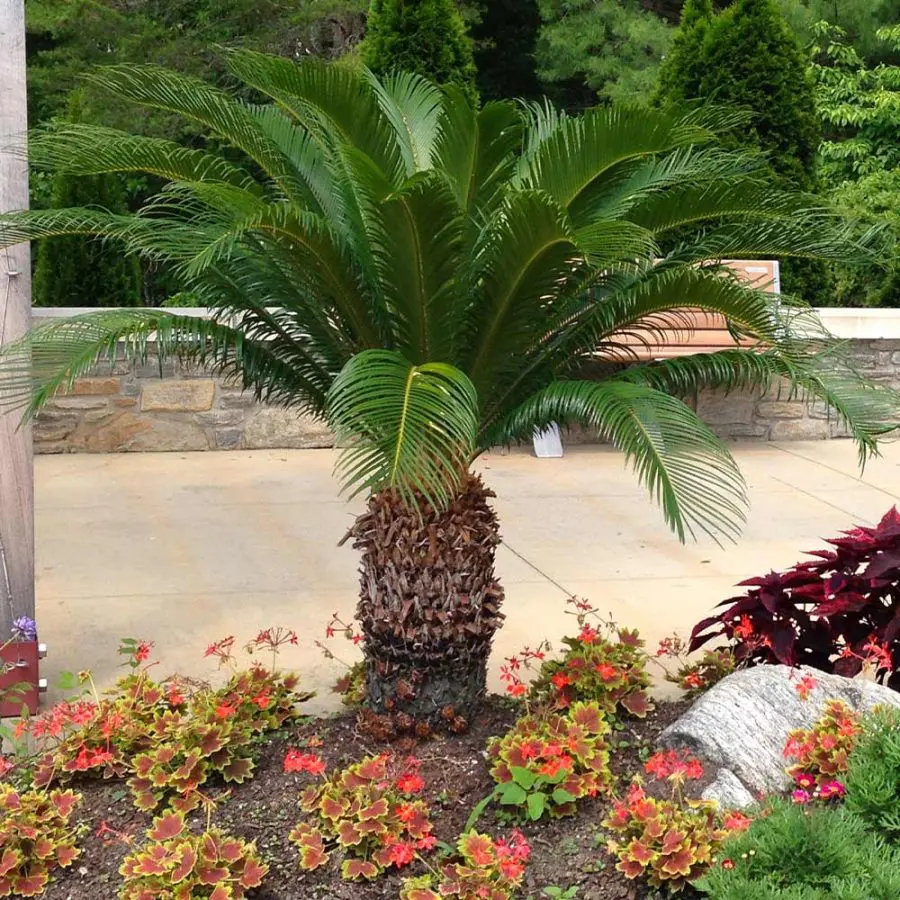
Watering and maintenance are key factors to consider when growing sago palms in pots.
These plants require regular watering and proper care in order to thrive and produce healthy foliage.
In this section, we’ll cover the best practices for watering your sago palm, how to check for signs of overwatering or underwatering, and other maintenance tasks you’ll need to perform to keep your plant healthy and happy.
With the right watering and maintenance routine, your sago palm will be able to flourish and provide a stunning addition to your home or garden.
Proper watering and maintenance are essential for the health and longevity of your sago palm.
Here are some tips for watering and maintaining your sago palm:
Tips on how much water sago palms need and how often they should be watered
• Sago palms require regular watering, but it’s important not to overwater them
• Water your sago palm deeply, but allow the soil to dry out partially before watering again
• In general, sago palms should be watered about once a week, but this can vary depending on the climate, size of the pot, and other factors
• Be careful not to let the soil become waterlogged, as this can lead to root rot and other problems
How to prune your sago palm and keep it healthy
Regular pruning can help your sago palm stay healthy and produce new growth
Use clean, sharp pruning shears to remove dead or yellowing fronds, and cut them off as close to the base of the plant as possible
Be careful not to damage the healthy new fronds, as this can lead to infection or other problems
VI. Sago Palm Problems
Sago palms are generally hardy and disease-resistant, but they can be susceptible to certain pests, such as spider mites, scale or mealybugs
If you notice signs of infestation, such as sticky residue or small insects on the fronds, try using a natural insecticide or wiping the plant down with a solution of soap and water
In some cases, sago palms may also develop yellowing or browning fronds, which can be a sign of nutrient deficiencies or other issues
Try adjusting your watering or fertilizing routine, or consult a gardening expert if you’re unsure what’s causing the problem
Diseases
Additionally, sago palms can be susceptible to diseases like fungal leaf spot and bacterial soft rot, which can cause discoloration, wilting, and other issues.
Another problem that may arise is improper watering, either over or under-watering, which can also harm the plant’s health.
Finally, lack of adequate light and incorrect temperature or humidity levels can also cause problems for indoor sago palms.
Insect pests
There are a few common problems that may arise when growing sago palms indoors.
Some common insect pests that can afflict indoor sago palms include scale insects, spider mites, and mealybugs.
If you notice any signs of infestation, such as yellowing leaves, sticky residue on the leaves, or visible bugs on the plant, you should take action to treat the problem.
One effective method for controlling these pests is to use a neem oil spray, which can suffocate the insects and their eggs.
You can also try using an insecticidal soap, which is less harmful to the plant but still effective against pests.
Be sure to follow the instructions carefully and apply the treatment thoroughly to all affected areas of the plant.
By following these tips, you’ll be able to keep your sago palm healthy and thriving. With regular care and attention, your sago palm can be a beautiful addition to your home or garden for many years to come.
VII. Fertilizing
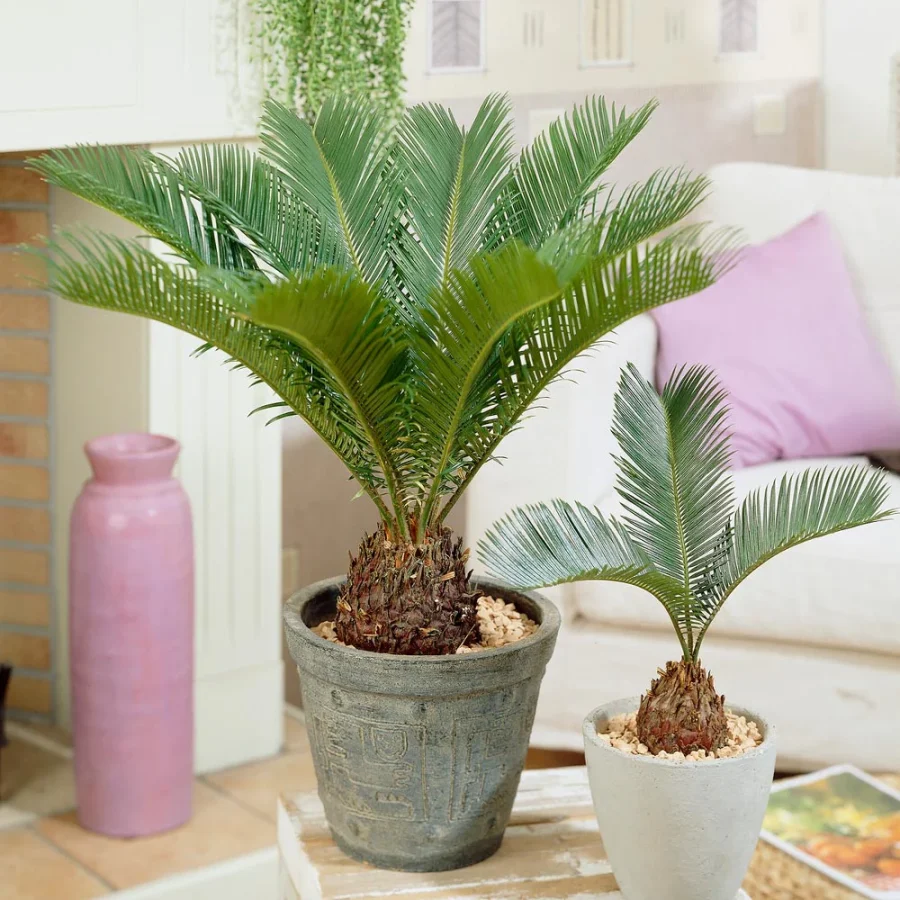
Fertilizing is an essential part of growing healthy sago palms in pots, but choosing the right type of fertilizer can be a challenge.
In this section, we’ll explore an alternative method for fertilizing sago palms using slow-release fertilizer spikes.
Unlike traditional liquid or granular fertilizers, these spikes provide a steady, continuous supply of nutrients to your plant over a long period of time.
We’ll discuss the benefits of using slow-release fertilizer spikes, how to apply them to your sago palm, and other tips for fertilizing your plant effectively.
With this approach, you can ensure that your sago palm gets the nutrients it needs to thrive and produce beautiful foliage.
Fertilizing is an important aspect of growing healthy sago palms in pots, and it’s crucial to choose the right fertilizer and apply it properly to avoid problems like over-fertilization or fertilizer burn.
In this section, we’ll delve into the details of fertilizing sago palms, including what kind of fertilizer they need and how often they should be fertilized.
Kind of Fertilizer
Sago palms require a balanced fertilizer with a ratio of nitrogen, phosphorus, and potassium.
The plant also requires some trace elements like magnesium, manganese, and iron, which can be included in a balanced fertilizer or provided separately.
Frequency of Fertilization
During the growing season, sago palms should be fertilized every four to six weeks. It’s important to avoid fertilizing during the winter months, as the plant goes dormant and doesn’t require as many nutrients.
Choosing the Right Fertilizer
When choosing a fertilizer for your sago palm, look for one that is specifically designed for palm trees and contains the right balance of nutrients.
Slow-release fertilizers can be a good choice because they release nutrients over a longer period of time, reducing the risk of over-fertilization.
Application of Fertilizer
When applying fertilizer, be sure to follow the instructions carefully and use the recommended amount.
It’s best to apply fertilizer to moist soil to avoid burning the plant’s roots.
Water your sago palm before and after applying the fertilizer to ensure that the nutrients are well-distributed throughout the pot.
Avoiding Over-Fertilization and Fertilizer Burn
Over-fertilization can damage your sago palm, causing leaves to turn brown and drop off.
Fertilizer burn can occur when too much fertilizer is applied or when it is applied to dry soil.
To avoid these problems, always follow the instructions on the fertilizer package and use the recommended amount.
Be sure to water your sago palm regularly to keep the soil moist, which can also help prevent fertilizer burn.
If you notice any signs of over-fertilization or fertilizer burn, flush the soil with water to remove any excess nutrients.
Most fertilizer problems can be eliminated by using slow-release fertilizer spikes.
The use of tree spikes will take the guesswork out of fertilizing.
Here is what I recommend for  fertilizing your sago palm.
fertilizing your sago palm.
I recommend using Jobes Organics fertilizer spikes.
They are easy to use and last for 2-3 months.
They are designed for container-grown citrus but work really well for palm trees.
Using 2 spikes for a 12-inch pot or 3 for an 18-inch pot takes the guesswork out of fertilizing.
They provide a 3-5-5 fertilizer blend along with micronutrients and beneficial bacteria.
VIII. Temperature and Humidity
Sago palms are native to tropical regions, so it’s no surprise that they prefer warm and humid conditions to thrive.
In this section, we will cover the ideal temperature and humidity levels for sago palms and how to maintain them in a potting environment.
We will also discuss common issues related to temperature and humidity, and how to solve them to keep your sago palms healthy and happy.
Temperature and Humidity Needs
Sago palms require warm and humid conditions to grow successfully. They are tropical plants and can’t tolerate cold weather, so it’s essential to maintain the ideal temperature for them.
In general, sago palms thrive in temperatures ranging from 70 to 85 degrees Fahrenheit.
In many areas, this will not be a suitable outdoor plant.
However, you can bring your plant outdoors during the summer months but make sure you bring it back inside before the weather cools.
Maintaining Temperature and Humidity
One way to maintain temperature and humidity levels for sago palms is to place them in a location with constant temperature and high humidity. However, that may not be possible for everyone.
Here are some tips on how to maintain the ideal temperature and humidity levels for your sago palms:
• Keep your sago palms away from cold drafts or air conditioning vents, which can cause sudden changes in temperature and humidity.
• Use a humidifier or a tray of water near your plant to increase humidity levels.
• Cover your sago palms with a light fabric or shade cloth to protect them from extreme heat and sunlight.
Monitoring and Adjusting Temperature and Humidity
It’s essential to monitor the temperature and humidity levels around your sago palms to ensure they are thriving.
You can use a thermometer and a hygrometer to measure the temperature and humidity levels, respectively.
If you find that the levels are not within the ideal range, you can take the following steps:
• Adjust the location of your sago palms to a spot with more or less exposure to light or airflow.
• Increase or decrease watering to control humidity levels.
• Use a fan to circulate the air around your sago palms and regulate the temperature.
By following these tips, you can ensure that your sago palms thrive and remain healthy in their potting environment.
IX. Harvesting Sago Palms
Growing sago palms in pots can be a rewarding experience, and with proper care and attention, you can enjoy the lush greenery of your sago palm for years to come.
But what if you want to take it to the next level? In this section, we’ll discuss the process of harvesting sago palms, including when and how to harvest seeds.
Sago palms are dioecious plants, which means that they have separate male and female plants.
Male sago palms produce pollen cones, while female sago palms produce female flowers on their seed cones. You will need both to produce viable seeds.
The easiest way to tell the difference between male and female plants is by examining the cones.
Male cones are long and cylindrical, while female cones are shorter and more rounded.
If you are interested in harvesting sago palm seeds, you will need a male plant to produce pollen and a female plant that is mature enough to produce seed cones.
It is important to note that sago palms are slow-growing, so it may take several years for a plant to reach maturity and produce seed cones.
If you don’t want to wait years to start new plants you can buy sago palm seeds online.
X. Sago Palm FAQs
Growing Sago Palms in pots comes with its own set of queries. The following FAQs address common concerns about soil mix, light requirements, and combating pests and diseases, to help you ensure the well-being of your potted Sago Palm.
Q. What type of soil is best for potted Sago Palms?
A. A well-draining soil mix, like a sandy loam or cactus mix, is ideal for Sago Palms to prevent water-logging and root rot.
Q. How much light do Sago Palms need?
A. Sago Palms thrive in bright, indirect light but can tolerate some direct sunlight.
Q. How often should I water my potted Sago Palm?
A. Watering should be moderate; allow the soil to dry out between waterings to prevent over-watering.
Q. How to manage pests on Sago Palms?
A. Regular inspection and cleaning, along with the use of insecticidal soap or neem oil, can help manage common pests like scale insects and spider mites.
XI. Conclusion
Thanks for checking out our guide to growing sago palms in pots! We hope you found the information helpful and feel inspired to give it a try.
Just to recap, we covered everything from choosing the right pot and soil to providing adequate light and water, and even how to fertilize your sago palm.
Plus, we discussed some common problems and how to deal with them.
If you’re ready to get started, go ahead and give it a try!
You can buy your Sago Palm here
You can learn more about growing palm trees indoors and palm tree care in this article.








